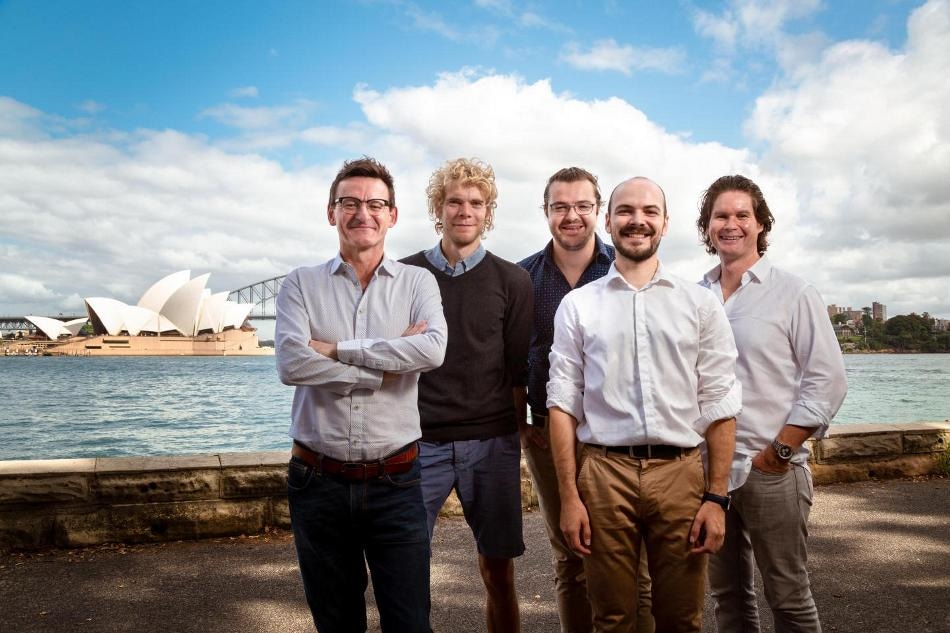Mar 12 2019
Thanks to a research collaboration between the University of Sydney and UNSW, an important barrier to making quantum computers in silicon has been overcome, paving the way to further improve the machines at scale.
 From left—Professor Andrew Dzurak (UNSW), Dr. Bas Hensen (UNSW), Anderson West (UNSW), Dr. Alexis Jouan (USYD), Professor David Reilly (USYD). (Image credit: Nyasha Nyakuengama, UNSW)
From left—Professor Andrew Dzurak (UNSW), Dr. Bas Hensen (UNSW), Anderson West (UNSW), Dr. Alexis Jouan (USYD), Professor David Reilly (USYD). (Image credit: Nyasha Nyakuengama, UNSW)
Both the teams, headed by Professor Andrew Dzurak at UNSW and Professor David Reilly at the University of Sydney, have shown that it is possible to read out the value, or state, of a quantum bit (qubit) in silicon in a way that eliminates the necessity to have readout sensors along with the qubits. The study results have been reported in Nature Nanotechnology.
This paper has combined using a single-gate electrode technique to read-out information - a method developed by David Reilly's group in 2013—with the requirement for single-shot readout of qubits that can be manufactured using existing silicon chip technology—a capability we developed in 2014. This mix is very important for scalability.
Andrew Dzurak, Professor, UNSW.
The building blocks of quantum computers are qubits. Countless numbers of qubits have to be constructed in intricate arrays before these next-generation machines can be used for solving major challenges facing mankind, such as aiding the development of machine learning or the design of novel medicines. This poses complicated design issues.
By eliminating the requirement for parallel readout sensors, the joint result enables a computing architecture that is relatively simpler, which means a host of additional qubits can be constructed alongside one another.
According to Professor Dzurak, the demonstration of the single-shot readout of a qubit in silicon is an outcome, whose time has come.
Four research teams across the world have developed very similar read-out techniques in silicon basically at the same time, all based on David's single-gate technique. Two of them in Australia, one in France and one in the Netherlands.
Andrew Dzurak, Professor, UNSW.
This is a great result that shows that scientific collaboration is key to achieving a fault-tolerant, universal quantum computer.” Such a machine will not be built in a single laboratory or a single institute. It will require cooperation on a global scale, working with some of the biggest technology companies in the world.
David Reilly, Professor, University of Sydney.
Professor Reilly is also the Director of the Microsoft Quantum Laboratory and holds a joint position at the University of Sydney. He is also a Chief Investigator at the ARC Centre of Excellence for Engineered Quantum Systems.
He added that “Our result is real evidence that the critical mass of people in Sydney is creating something greater than the sum of its parts. It’s not just parallel activity at different institutions.”
Professor Dzurak, who headed the project at UNSW, is a Chief Investigator in the ARC Centre of Excellence for Quantum Computation & Communication Technology and Director of the Australian National Fabrication Facility (ANFF) at UNSW. He stated that one of the world’s strongest quantum research ecosystems can be found in Sydney.
“I can't think of another city in the world with as many people doing quantum computing,” he stated. “We have teams at UNSW, Sydney, Macquarie and UTS working across the spectrum: on hardware, quantum control, quantum measurement right through to quantum software. It's all here in Sydney.”
According to Professor Reilly, this study is being performed simultaneously with the commercialization of the technology.
“I have a position with Microsoft and Andrew leads a project with Silicon Quantum Computing. By working together, we are showing strong academic collaboration alongside an emerging quantum economy,” he stated.
One of the great things about this result is it has been put together by people coming to Sydney from across the world, attracted to the strong quantum science ecosystem we have built here.
Andrew Dzurak, Professor, UNSW.
I was attracted to working with Professor Dzurak and his team from the US as I was really impressed by what they were doing with silicon qubits.
Anderson West, Study Lead Author and PhD Student, UNSW.
Dr Bas Hensen, the study’s corresponding author, joined UNSW from the Netherlands, where he had already established himself by experimentally showing an important principle of quantum mechanics utilizing entangled qubits in diamond. “I was keen to get involved with qubits in silicon and UNSW was clearly the place to be for that,” he said.
Dr Alexis Jouan from the University of Sydney, who took part in the study, is originally from France where he studied two-dimensional (2D) superconductors at high frequency. “I am very glad to be in the Reilly group at Sydney, which is one of the best places to continue exploring the quantum world,” he said.